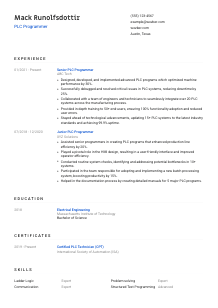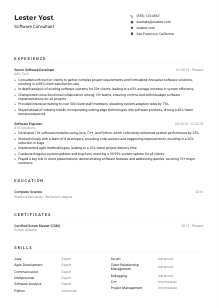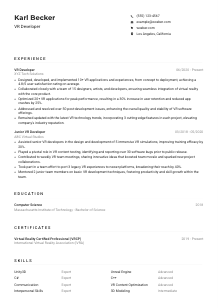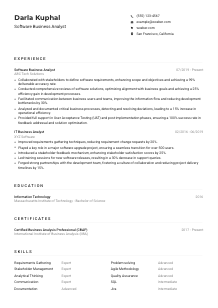PLC Programmer Resume Example
Juggling ladder logic, but your resume isn't getting the green light? Delve into this PLC Programmer resume example, programmed with Wozber free resume builder. Witness how you can seamlessly translate your automation expertise to meet job criteria, keeping your career in sync with top programming positions!
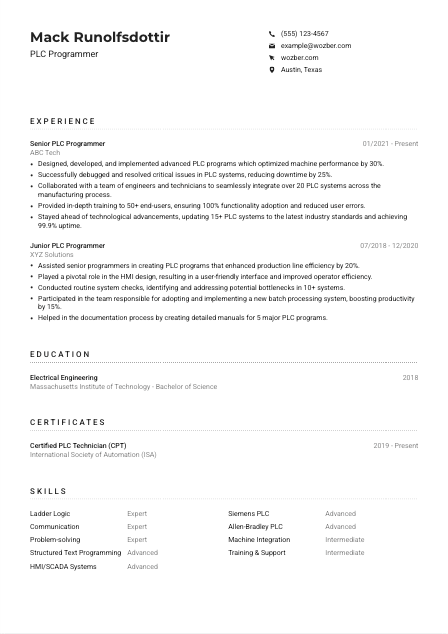
How to write a PLC Programmer resume?
Are you ready to supercharge your journey as a PLC Programmer? Crafting a resume that stands tall amidst the competition is your first step. And guess what? It's not just about listing your accomplishments; it's about aligning them with what your dream job demands. With a focus on ATS optimization and addressing the specifics of a PLC Programmer role, this guide is your golden ticket.
Using the free resume builder, Wozber, you're about to dive into the art and science of creating an ATS-compliant resume that lands you interviews. Ready to roll up your sleeves? Let's program your career success!
Personal Details
Make your resume's Personal Details section not just seen but remembered. This is where every detail matters, mirroring the precision required in PLC programming.
1. Crafting a Name That Stands Out
Just like a well-labeled PLC program, your name should be clear and prominent. Opt for a slightly larger font to ensure it catches the eye.
2. Positioning Yourself with the Right Title
Place the title 'PLC Programmer' right below your name to match the job description. It's like setting the function of a program before diving into the code.
3. Streamlining Your Contact Information
Provide a phone number and a professional email, ideally in the firstname.lastname@email.com format. Ensure each piece of info is like a well-defined variable in your program - absolutely error-free.
4. Mapping Your Location Mindfully
Since the job demands being in or relocating to Austin, Texas, highlight this location upfront. It's akin to meeting the system requirements before a program's deployment.
5. Leveraging a Professional Online Presence
Link to your LinkedIn profile to offer a dynamic view of your professional journey. Ensure it's updated and echoes the professionalism of your resume.
Takeaway
In PLC programming, clarity and accuracy are paramount, and the same goes for your resume's Personal Details. Treat this section like your program's header, setting the stage for the intricate details that follow. A polished and precise introduction can indeed make a difference.





Experience
Ready to showcase your knack for optimizing machine performance through precise PLC programming? The Experience section is where you flex your technical muscles. Here's how to frame your achievements in a way that speaks directly to the needs of hiring managers.
- Designed, developed, and implemented advanced PLC programs which optimized machine performance by 30%.
- Successfully debugged and resolved critical issues in PLC systems, reducing downtime by 25%.
- Collaborated with a team of engineers and technicians to seamlessly integrate over 20 PLC systems across the manufacturing process.
- Provided in‑depth training to 50+ end‑users, ensuring 100% functionality adoption and reduced user errors.
- Stayed ahead of technological advancements, updating 15+ PLC systems to the latest industry standards and achieving 99.9% uptime.
- Assisted senior programmers in creating PLC programs that enhanced production line efficiency by 20%.
- Played a pivotal role in the HMI design, resulting in a user‑friendly interface and improved operator efficiency.
- Conducted routine system checks, identifying and addressing potential bottlenecks in 10+ systems.
- Participated in the team responsible for adopting and implementing a new batch processing system, boosting productivity by 15%.
- Helped in the documentation process by creating detailed manuals for 5 major PLC programs.
1. Dissecting the Job Description
Just as you would with a new project's specifications, break down the job requirements. Match your past roles with the demands of being a PLC Programmer, especially focusing on PLC programming platforms like Siemens or Allen-Bradley.
2. Structuring Like a Pro
List your experiences in reverse chronological order, mirroring the way a PLC log operates - with the most recent entries first. Include your title, company, and dates, just as you'd structure a well-organized code.
3. Crafting Achievement-Focused Statements
For each role, highlight accomplishments that resonate with the job's needs, such as optimizing machine performance or debugging. Quantify your successes, like reducing downtime by 25%, to add tangible value to your narrative.
4. Balancing Quantity with Relevance
Stick to relevant experiences that mirror the job requirements. Like unnecessary code that could slow down a program, extraneous job experiences can divert attention from your core qualifications.
5. Speaking the Language of PLC Programming
Use terminology and achievements specific to PLC programming. Words like 'ladder logic,' 'structured text,' or 'HMI/SCADA systems' should be woven into your narrative, showcasing not just your abilities but also your industry acumen.
Takeaway
Transform the Experience section into a compelling log of your PLC programming journey. It's more than just listing roles; it's about telling a story of problem-solving, system optimization, and continuous learning. Frame your experiences to make hiring managers eager to learn more about the program behind the programmer.
Education
A solid educational background in Electrical, Computer Science, or related fields lays the groundwork for a successful PLC Programmer. Let's ensure your Education section reflects not just qualifications but a commitment to your craft.
1. Aligning With Key Requirements
Start by spotlighting your relevant degree that matches the job's educational prerequisites. Mentioning a Bachelor's degree in Electrical Engineering or related field directly connects your academic background to the job's demands.
2. Emphasizing Structured Education
Keep this section clean and succinct, presenting your degree, institution, and graduation year in a structured format, much like structuring a block of code for maximum readability.
3. Highlighting Degree Specificity
Explicitly list your field of study to echo the job description. If 'Electrical Engineering' is the magic word, ensure it's there, undiluted and clear.
4. Mentioning Relevant Courses or Projects
Though not always necessary for seasoned professionals, citing specific courses or projects can be a boon for those earlier in their careers, provided these align with the demands of a PLC Programmer role.
5. Showcasing Continuous Learning
If you've pursued further education, certifications, or special courses relevant to PLC programming or technology updates, mention these. It shows a dedication to staying ahead in a rapidly evolving field.
Takeaway
Your Education section should serve as a testament to your foundational knowledge and your eagerness to dive into the depths of PLC programming. It's not just a list of qualifications but a reflection of your journey towards becoming an expert in your field.
Certificates
In the fast-paced world of technology, certifications serve as badges of honor, showcasing your dedication and expertise. Let's pinpoint how to highlight these in the context of a PLC Programmer.
1. Identifying Relevant Certifications
Start with certifications that have direct relevance to PLC programming, such as 'Certified PLC Technician.' This strategically aligns your resume with the job description, showcasing your commitment to your specialization.
2. Prioritizing Quality Over Quantity
List certifications that strengthen your application for the PLC Programmer role. It's about presenting the most relevant accolades, not every certificate you've ever earned.
3. Maintaining Current Credentials
Ensure your certifications are up-to-date. Outdated certifications can be a red flag, while current ones underscore your commitment to keeping your skills sharp.
4. Seeking Continuous Improvement
The tech landscape is ever-changing, and so should your expertise. Regularly update your certifications and continue seeking new ones that align with your career trajectory as a PLC Programmer.
Takeaway
Your certificates are more than just accolades; they're a reflection of your drive for continuous improvement and a testimony to your expertise in PLC programming. Highlight them wisely to strengthen your resume and appeal to prospective employers.
Skills
The Skills section is your resume's toolbox, ready to impress with your professional capabilities. For a PLC Programmer, this means highlighting both technical and soft skills critical to the role.
1. Deciphering the Job Description
Scrutinize the job description for both explicit and inferred skills. Hard skills like 'ladder logic' and 'structured text programming' should be complemented with soft skills such as 'effective communication.'
2. Curating a Matched List
Align your skills with those requested in the job description, ensuring a balanced mix of technical prowess and interpersonal abilities. Prioritize skills where your proficiency is strongest.
3. Organizing for Impact
Avoid cluttering with every skill you possess. Showcase your top skills in a structured and easy-to-scan format, making it straightforward for hiring managers to see you're a fit.
Takeaway
View your Skills section as the command center of your resume, controlling the narrative around your capabilities. Precision in matching these to the job description ensures your resume speaks the right language, making it impossible for hiring managers to ignore.
Languages
In our interconnected world, language skills can open doors and foster better collaborations. While not always central for a PLC Programmer, they're worth highlighting, especially in diverse and global teams.
1. Evaluating the Job's Language Needs
Given the emphasis on English proficiency, prioritize this in your resume. A 'Native' or 'Fluent' level indicates you're ready to communicate effectively in professional settings.
2. Listing Your Languages Strategically
Start with languages most relevant to the job, highlighting your proficiency level. For global roles, additional languages can underscore your ability to work in diverse environments.
3. Being Honest About Your Skill Level
Clearly define your proficiency for each language, using terms like 'Native,' 'Fluent,' or 'Intermediate.' This ensures expectations are aligned from the start.
4. Recognizing the Broader Benefits
Beyond job requirements, languages can enhance your capacity for problem-solving and cultural understanding, valuable assets in any role.
5. Considering Future Opportunities
For roles involving international projects or teams, additional languages can be a significant advantage, positioning you for a broader range of opportunities.
Takeaway
Your language skills are not just about communication; they're a mark of your adaptability and readiness for global collaboration. Highlight them appropriately to reflect the diverse professional you are, ready to engage in a rapidly evolving global workspace.
Summary
Your Summary is the elevator pitch of your resume, a chance to hook the hiring manager with a snapshot of your professional self. Let's craft a summary that reflects your qualifications and ambition as a PLC Programmer.
1. Grasping the Job's Core
Begin with a deep understanding of the role's requirements. A summary that addresses these needs directly sets a strong foundation for the rest of your resume.
2. Introducing Your Professional Self
Start with a statement that encapsulates who you are as a professional – a PLC Programmer with a proven track record, for example.
3. Highlighting Your Unique Contributions
Briefly mention your expertise in areas like ladder logic, structured text, or HMI/SCADA systems. Make it clear how you've used these skills to make tangible impacts in your previous roles.
4. Keeping It Concise and Powerful
Your summary should be a high-impact teaser, not an exhaustive account. Aim for 3-5 lines that invite the reader to learn more about your professional journey.
Takeaway
Consider your Summary the handshake that starts the conversation. Make it strong, confident, and reflective of your capabilities and aspirations as a PLC Programmer. By directly addressing the job's requirements from the get-go, you set the stage for a resume that resonates with purpose.
Initializing Your Career Programming
Congratulations on completing your tour through the landscape of a PLC Programmer's resume. Equipped with insights and strategies tailored to your profession, you're now ready to use Wozber's free resume builder, featuring ATS-friendly resume templates and an ATS resume scanner, to craft a document that not only meets but exceeds hiring expectations. Your resume is your program, meticulously coded to launch you into your next adventure.
Go ahead, let your achievements shine, and open the door to new opportunities. Your future as a PLC Programmer awaits – it's time to press 'Run.'

- Bachelor's degree in Electrical, Computer Science, or related fields.
- Minimum of 3 years of experience in PLC programming, preferably with Siemens or Allen-Bradley platforms.
- Proficiency in ladder logic and structured text programming.
- Strong working knowledge of HMI/SCADA systems.
- Effective communication and problem-solving skills.
- Must be able to communicate effectively in English.
- Must be located in or willing to relocate to Austin, Texas.
- Design, develop, and implement PLC programs based on project specifications.
- Troubleshoot and debug PLC systems to ensure optimum performance and minimal downtime.
- Collaborate with cross-functional teams, including engineers and technicians, to ensure seamless integration of PLC systems.
- Provide training and support to end-users on PLC-related functionalities.
- Stay updated with the latest industry standards and technologies to ensure the PLC systems remain cutting-edge.





